
13 Jan The Marvels of Railway Station Engineering
World, as vast and complicated as it is, has a unique way of concealing its jewels. Most secluded places can sometimes unearth the shiniest ones, like medieval towns in Dalmatia, Tibetan mountain villages or the fairytale castles of Germany. A tumultuous culture of rich history is hidden all around us, and all we have to do is actually look for it. Often large and hidden in plain site, architectural wonders are being forgotten due to the busy life we live. Once we stop and look around, we can discover the beauty in our hometowns, and appreciate our enlightening past.
Travel, Not a Destination
We often rush from place to place, catch plains and curse metros. The truth is, everyday obligations and headaches are making us forget all about the simple enjoyments of travelling. Well, someone remembered to make transport a voyage (which are really two different things). While waiting on a train to take us to a business meeting, railway stations across the world are forcing us to take a moment and breathe in the beauty. To take something blank and prosaic and to turn it into a thing of enchantment, that’s art. And that’s why railway station architects are virtuosos.
In the beginning, railway stations were small and utilitarian. It’s the 19th century that brought interest in them as objects of art. The first beautified railway station, as we know them nowadays, was built in 1830 in Manchester, from where trains took off for Liverpool. The Liverpool Road Station is the oldest joint station, and the only preserved one. Its construction resembled a row of houses in Georgian style. Since then, train stations were built in a grandiose manner, mostly as Baroque and Gothic constructions. Those that have survived since are considered historical landmarks and honored as architectural marvels. Here’s the story of how some of them have been made.
Haydarpaşa Terminal,Istanbul, Turkey
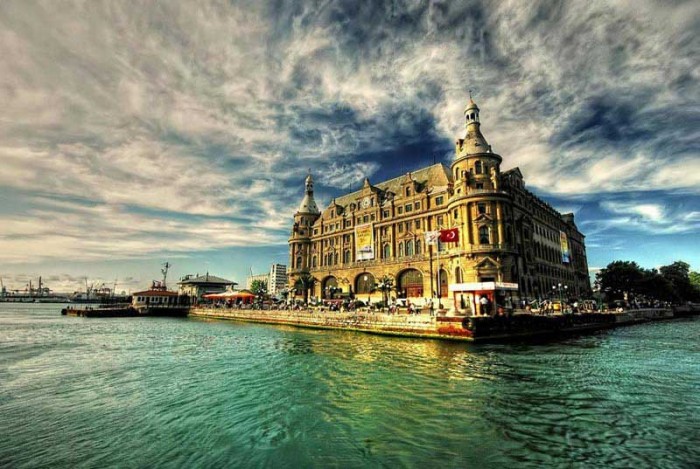
Finished and opened in 1909, as an anniversary gift for Mehmed the Fifth, Haydarpaşa Terminal is situated on the mere waterside of the Bosphorus. The building had two main caretakers, both of German origin, Otto Ritter and Helmut Conu. In the heart of the former Ottoman Empire, German architects chose a very European style. Thanks to them, this station remained one of the symbols of the neo-classical style. In fact, not only the station, but the whole neighborhood surrounding it, had an architectural makeover in this predominant style, and established itself as a German neighborhood. Due to neo-classical provenance, the magnificent front building of the terminal resembles a castle. The sandstone façade was decorated with a little help from Italian stonemasons, so it bears a true mark of the Renaissance Revival architecture. The roof is pitched and made of slate, and the center tower presents a clock as a motif of these stations, while front corner walls carry circular turrets. On the inside, walls are embellished with trailing foliage cartouches as well as garlands. As a witness to a turbulent past, this station is a true inspiration.
Kuala Lumpur Railway Station, Kuala Lumpur, Malaysia
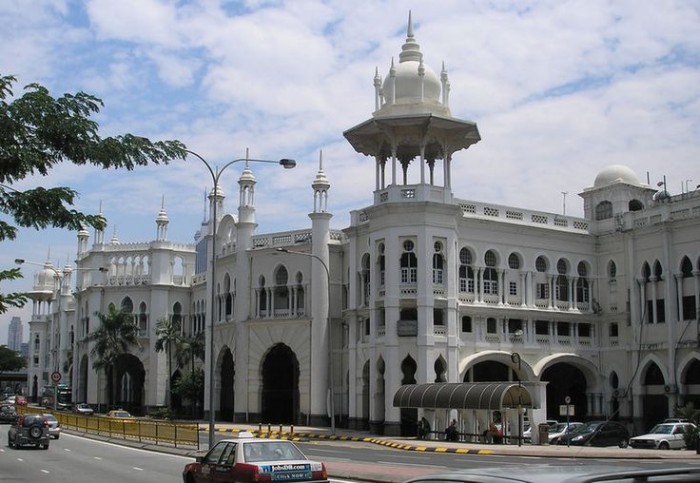
Usually declared the world’s most beautiful railway station, this terminal is worthy of all praise. Architecturally complex, the station was built back in 1910 by the British architect Arthur Benison Hubback. Its design is an unexampled combination of Anglo-Asian styles, all blended into one hell of a term – The “Neo-Moorish/Mughal/Indo-Saracenic/Neo-Saracenic” style. The unique construction includes a central terminal building with three platforms. The amalgam style of the main hall is Raj, which is a combination of Western and Mughal architecture. Ogee and horseshoe arches have complete domination over the hall, with corner chhatris. Later on, an additional building was designed in the north part of the site, and designed with a Western influence, completed with verandas and more arches, now segmental. The façade of the breathtakingly beautiful building is plastered and freshened up with a bright, white color. The Station Hotel in the same style is incorporated to the terminal, and open for tourists and train commuters. Faced with such extraordinary sights, one cannot fully grasp its materiality.
Chhatrapati Shivaji Terminus, Mumbai, India
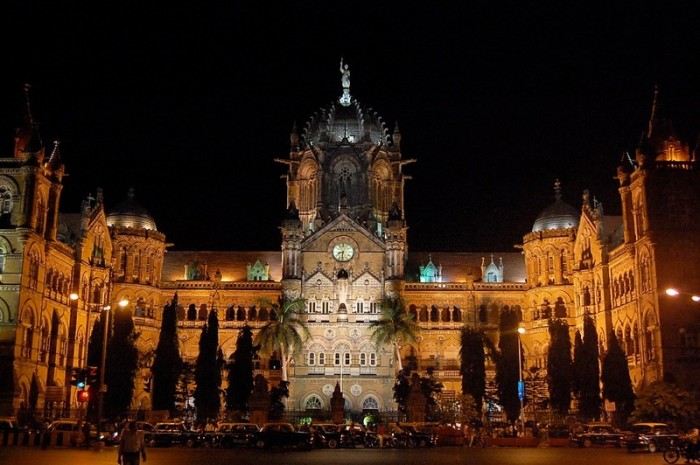
European architecture has a unique way of fusing with Asian architecture. The Chhatrapati Shivaji Terminus is one of the finest exhibits. With Victorian Italianate Gothic Revival style and Mughal construction, so typical for the Hindu culture, this station offers an architectural experience of a rare kind. The palace-like building was designed in the bygone 1887, under the instructions of Frederic William Stevens. Initially, the terminal was called Victoria Terminus, in honor of Queen Victoria, for her Golden Jubilee. The latter name was given to the station after the Great king of India. As a part of the exterior, turrets and arches pointed to the sky, the light motifs of Indian architecture came perfectly juxtaposed to the Victorian façade. The façade itself is covered with captivating stone carvings that form various symbols of local flora and fauna and human portraits. The stone alone is equally attractive – malad stones in a shade of yellow, specific for local architecture. The European influence is obvious in Italian marble and polished granite. In between Burma’s teak wood windows, you will find some grotesque statues, representing Indian castes. The unity of British and local can also be seen on the main entrance, formed with two columns, crowned with a lion and a tiger, the first symbolizing United Kingdom, and other India. A true architectural pledge between two countries, and a sight to be seen in vivo.
St. Pancras railway station, London, England
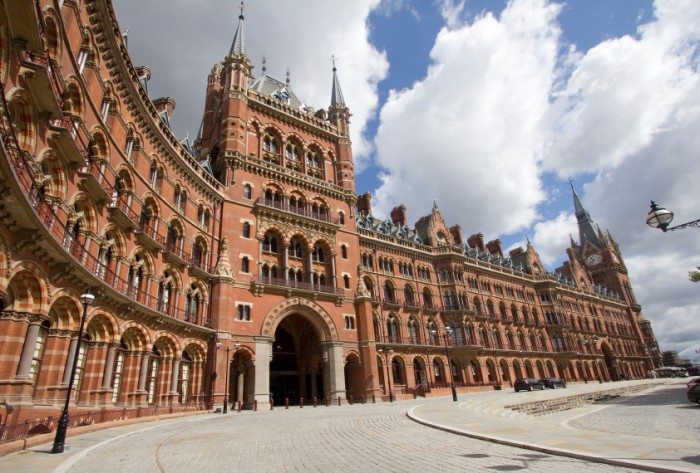
“Cathedral of the railways“, as it’s generally being referred to, St. Pancras railway station is the most exquisite of all European terminals. Its construction finished in 1868, with two different architects putting their brilliant minds into its design. Situated in the architectural neighborhood with the British Library, the famous King’s Cross station and the Regent’s Canal encircling it, this station is a true gemstone of central London. The terminal itself was created by William Henry Barlow, as the most specious at the time, with a 243-foot single-span expended in depth. Due to the transparent skeleton structure, the train shed gained unrealistic appearance, much ahead of its time. Front building had a different master. George Gilbert Scott made not only a façade, but an entire hotel, which was to become the second most magnificent building of Victorian Gothic style in London. Midland Grand Hotel, as it is still called, echoed with opulence and prestige. The interior was embellished with gold-leafed and stencil walls, painted in vivid colors. The Gothic exterior and colorful interior are linked with a coach gate rich in details and representative of such splendor.
The popular symbol of the station is a bronze statue located beneath the terminal clock, with a nostalgic title – The Meeting Place. The author is Paul Day, the honored British sculptor. It is the most heartwarming portrayal of railway stations as places of renewed gatherings and reunited lovers. Beside for this one, St. Pancras holds place for other sculptures as well, establishing itself as a site of the art. Just a reason more for remaining the most poetic of world’s train stations.
Antwerpen-Centraal railway station, Antwerpen, Belgium
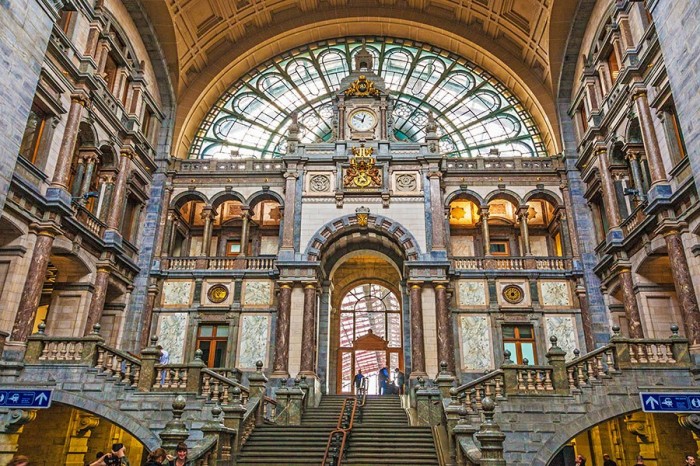
As a postcard from the past, the Antwerpen railway station adorns the lovely Belgium city of the same name with dramatic magnificence. The period of its construction was unusually long, from 1895 to 1905. The main building of the terminal was built with a stone clad technique, and it was devised by Louis Delacenserie. The central architectural feature of the terminal is a large dome that outflanks the railways and, besides being impressive art-vise, serves a valuable and smart purpose – it was originally designed as a vent for locomotive steam. A train shed, however, was engineered by Clement van Bogaert, and turned out hugely far-flung. The use of iron and glass for roofing created a unique, semi-transparent effect of an open sky. The third creditable architect is Jan Van Asperen, who designed a viaduct.
The architectural style in which the Antwerpen station has been built is hard to define. With eclecticism, impressiveness and lavishness, the construction simply amazes. Architecture enthusiasts or not, travelers rush to it from all parts of the world, and with a great reason.
Grand Central Terminal,New York, New York
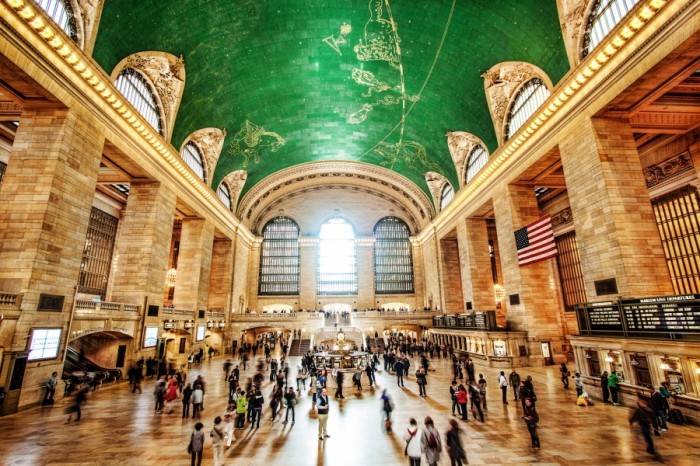
The Capital of the World deserves nothing less than this miracle of architecture and style. As a place of brief encounters and love stories, Grand Central Terminal is among the most recognizable sights in the world. And it’s all happening in the construction’s mother ship, the Main Concourse. If the Main Concourse is the very core of the entire station, then the iconic clock above is its heart. The brass clock, created by Henry Edward Bedford is quadrilateral, with each side constructed from delicate (and very expensive) milk glass. Another clock, fixed on the façade is made of New York’s trademark Tiffany glass. Furthermore, the façade is decorated with three large sculptures, representing the Greek and Roman pantheon – Hercules, Minerva and Mercury, each created by Jules-Felix Coutan.
The third thrilling art piece incorporated into the station’s architecture is a ceiling, decorated with astronomical motifs. The initial design was done in 1912, by the main architect and his partner Paul César Helleu, the French artist. What’s interesting is that the mural was astronomically incorrect, although they had a team of astronomers to consult with. Curiosity or not, the painted constellations are absolutely dreamlike.
Union Station, Los Angeles, California
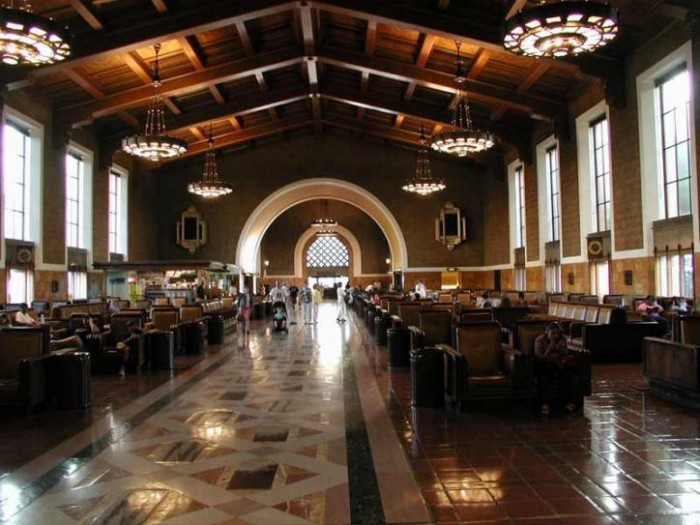
The well-known title for this station is “Last of the Great Railway Stations”, which refers to the United States terminals. As such, it was enlisted as a historical landmark. Its functionality aside, the Union Station is the most impressive of all the train stations on the continent. It’s the brainchild of the so-called Parkinsons – John Parkinson and Donald B. Parkinson, whose participation in Los Angeles architectural making is more than influential. Another admixture of manners, this station was designed in three preeminent styles. As a token of yet another architect involved, European Jan van der Linden, the construction includes aspects of a Dutch Colonial Revival style. As one of the most recognizable architectural styles of the American West, particularly present in railroad engineering, and adopted from Latin neighbors, Mission Revival had a huge impact on this building. Finally, the Streamline Moderne style, as a late variation of Art-Deco, was featured with embellishments like octograms.
Smooth materials such as travertine marble and terra cotta were used significantly, especially in the waiting room construction. Surprisingly, the ceiling of the room has been made with steel, although its appearance resembles wood. Multiple garden patios are encompassing the waiting room. Another remarkable sight in the station is a famous Harvey House restaurant, constructed by Mary Colter, with its distinct floor patterns and streamlined booths. Although small-scale by Euro-Asian railway station standards, the Union Station is a lovely and exciting place to spend an afternoon before departing from the dearest ones.
***
So, when busy and in a rush, remember to brighten up the day with a visual postcard. Glance, inhale and touch. Cherish the beauty around you and learn something new. It’s never too late to get familiar with yet another art form, and what is more interactive then architecture? While waiting on a train, fold your magazine, lay down your tablet, and enjoy. While changing the world, architecture has a way of changing the way we experience it. Ultimately, that is the most exciting ride.

